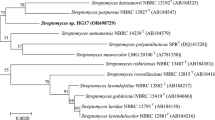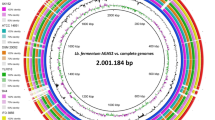Abstract
A bacterium that converted daidzein to O-desmethylangolensin was isolated from the feces of healthy humans. It was an obligately anaerobic, nonsporeforming, nonmotile and Gram-positive rod. The isolate used glucose, sucrose, raffinose, maltose, and fructose as carbon sources. It did not hydrolyze gelatin, esculin, or starch. The strain was urease, acid phosphatase, and arginine dihydrolase positive. It was catalase, oxidase, H2S, and indole negative. The major products of glucose fermentation were butyrate and lactate. Its mol% G+C was 51.2. The major cellular fatty acids were C16:0 DMA, C16:0, and C16:0 aldehyde. The structural type of cell wall peptidoglycan was suggested to be A1γ. The isolate was susceptible to β-lactam, cefem, and macrolide antibiotics and resistant to aminoglycoside and quinolone antibiotics. The bacterium was related to Eubacterium ramulus ATCC29099T, Eubacterium rectale ATCC33656T, and species of the genus Roseburia, but the highest 16S rRNA gene similarity to these described species was only 94.4%, consistent with its being classified as a novel genus. Based on the above, the isolate, named strain SY8519, was identified as belonging to a novel genus in the Clostridium rRNA cluster XIVa.



Similar content being viewed by others
References
Akaza H, Miyanaga N, Takashima N, Naito S, Hirano Y, Tsukamoto T, Mori M (2002) Is daidzein non-metabolizer a high risk for prostate cancer? A case-controlled study of serum soybean isoflavone concentration. Jpn J Clin Oncol 32:296–300
Altschul SF, Madden TL, Schaffer AA, Zhang JH, Zhang Z, Miller W, Lipman DJ (1997) Gapped BLAST and PSI-BLAST: a new generation of protein database search programs. Nucleic Acids Res 25:3389–3402
Arai Y, Uehara M, Sato Y, Kimira M, Eboshida A, Adlercreutz H, Watanabe S (2000) Comparison of isoflavones among dietary intake, plasma concentration and urinary excretion for accurate estimation of phytoestrogen intake. J Epidemiol 10:127–135
Braune A, Gütschow M, Engst W, Blaut M (2001) Degradation of quercetin and luteolin by Eubacterium ramulus. Appl Environ Microbiol 67:5558–5567
Brienholt V, Larsen JC (1998) Detection of weak estrogenic flavonoids using a recombinant yeast strain and a modified MCF7 cell proliferation assay. Chem Res Toxicol 11:622–629
Collins MD, Lawson PA, Willems A, Cordoba JJ, Fernandez-Garayzabal J, Garcia P, Cai J, Hippe H, Farrow JAE (1994) The phylogeny of the genus Clostridium: proposal of five new genera and eleven new species combinations. Int J Syst Bacteriol 44:812–826
Downes J, Munson MA, Radford DR, Spratt DA, Wade WG (2002) Shuttleworthia satelles gen. nov., sp. nov., isolated from human oral cavity. Int J Syst Evol Microbiol 52:1469–1475
Duncan SH, Flint HJ (2008) Proposal of a neotype strain (A1–86) for Eubacterium rectale. Request for an opinion. Int J Syst Evol Microbiol 58:1735–1736
Duncan AM, Merz-Demlow BE, Xu X, Phipps WR, Kurzer MS (2000) Premenopausal equol excretors show plasma hormone profiles associated with lowered risk of breast cancer. Cancer Epidemiol Biomarkers Prev 9:581–586
Duncan SH, Hold GL, Barcenilla A, Stewart CS, Flint HJ (2002) Roseburia intestinalis sp. nov., a novel saccharolytic, butyrate-producing bacterium from human faeces. Int J Syst Evol Microbiol 52:1615–1620
Duncan SH, Aminov RI, Scott KP, Louis P, Stanton TB, Flint HJ (2006) Proposal Roseburia faecis sp. nov., Roseburia hominis sp. nov., Roseburia inulinivorans sp. nov., based on isolates from human faeces. Int J Syst Evol Microbiol 56:2437–2441
Frankenfeld CL, McTiernan A, Aiello EJ, Thomas WK, LaCroix K, Schramm J, Schwartz SM, Holt VL, Lampe JW (2004a) Mammographic density in relation to daidzein-metabolizing phenotypes in overweight, postmenopausal women. Cancer Epidemiol Biomarkers Prev 13:1156–1162
Frankenfeld CL, McTiernan A, Tworoger SS, Atkinson C, Thomas WK, Stanczyk FZ, Marcovina SM, Weigle DS, Weiss NS, Holt VL, Schwartz SM, Lampe JW (2004b) Serum steroid hormones, sex hormone-binding globulin concentrations, and urinary hydroxylated estrogen metabolites in post-menopausal women in relation to daidzein to daidzein-metabolizing phenotypes. J Steroid Biochem Mol Biol 88:399–408
Gylswyk NO, Hippe H, Rainey FA (1996) Pseudobutyrivibrio ruminis gen. nov., sp. nov., a butyrate-producing bacterium from the rumen that closely resembles Butyrivibrio fibrisolvens in phenotype. Int J Syst Bacteriol 46:559–563
Howes JB, Sullivan D, Lai N, Nestel P, Pomeroy S, West L, Eden JA, Howes LG (2000) The effects of dietary supplementation with isoflavones from red clover on the lipoprotein profiles of post menopausal women with mild to moderate hypercholestrolaemia. Atherosclerosis 152:143–147
Hur HG, Beger RD, Heinze TM, Lay JO Jr, Freeman JP, Dor J, Rafii F (2002) Isolation of an anaerobic intestinal bacterium capable of cleaving the C-ling of the isoflavonoid daidzein. Arch Microbiol 178:8–12
Ingram D, Sanders K, Kolybaba M, Lopez D (1997) Case-control study of phyto-oestrogens and breast cancer. Lancet 350:990–994
Katayama-Fujimura Y, Komatsu Y, Kuraishi H, Kaneko T (1984) Estimation of DNA base composition by performance liquid chromatography of its nuclease P1 hydrolysate. Agric Biol Chem 48:3169–3172
Kawamoto I, Oka T, Nara T (1981) Cell wall composition of Micromonospora olivoasterospora, Micromonospora sagamiensis, and related organisms. J Bacteriol 146:527–534
Kelly GE, Joannou GE, Reeder AY, Nelson C, Waring MA (1995) The variable metabolic response to dietary isoflavones in humans. Proc Soc Exp Biol Med 208:40–43
Kinjo J, Tsuchihashi R, Morito K, Hirose T, Aomori T, Nagao T, Okabe H, Nohara T, Masamune Y (2004) Interactions of phytoestrogens with estrogen receptors α and β (III). Estrogenic activities of soy isoflavone aglycones and their metabolites isolated from human urine. Biol Pharm Bull 27:185–188
Kuiper GG, Lemmen JG, Carlsson B, Corton JC, Safe SH, van der Saag PT, van der Burg B, Gustafsson JA (1998) Interaction of estrogenic chemicals and phytoestrogens with estrogen receptor beta. Endocrinol 139:4252–4263
Kumar S, Tamura K, Nei M (2004) MEGA3: integrated software for molecular evolutionary genetics analysis and sequence alignment. Brief Bioinfom 5:150–163
Lydeking-Olsen E, Jensen JBE, Setchell KDR, Damhus M, Jensen TH (2002) Isoflavone-rich soymilk prevents bone-loss in lumbar spine of postmenopausal women. J Nutr 132:581S
Maruo T, Sakamoto M, Ito C, Toda T, Benno Y (2008) Adlercreutzia equolifaciens gen. nov., sp. nov., an equol-producing bacterium isolated from human faeces, and emended description of the genus Eggerthella. Int J Syst Evol Microbiol 58:1221–1227
Minamida K, Tanaka M, Abe A, Sone T, Tomita F, Hara H, Asano K (2006) Production of equol from daidzein by gram-positive rod-shaped bacterium isolated from rat intestine. J Biosci Bioeng 102:247–250
Minamida K, Ota K, Nishimukai M, Tanaka M, Abe A, Sone T, Tomita F, Hara H, Asano K (2008) Asaccharobacter celatus gen. nov., sp. nov., isolated from rat caecum. Int J Syst Evol Microbiol 58:1238–1240
Moore WEC, Johonson JL, Holdeman LV (1976) Emendation of Bacteroidaceae and Butyrivibrio and descriptions of Desulfomonas gen. nov. and ten new species in the genera Desulfomonas, Butyrivibrio, Eubacterium, Clostridium, and Ruminococcus. Int J Syst Bacteriol 26:238–252
Nakazawa F, Hoshino E (1994) Genetic relationships among Eubacterium species. Int J Syst Bacteriol 44:787–790
Ozasa K, Nakao M, Watanabe Y, Hayashi K, Miki T, Mikami K, Mori M, Sakauchi F, Washio M, Ito Y, Suzuki K, Wakai K, Tamakoshi A, Study Group JACC (2004) Serum phytoestrogens and prostate cancer risk in a nested case-control study among Japanese men. Cancer Sci 95:65–71
Richardson AJ, Calder AG, Stewart CS, Smith A (1989) Simultaneous determination of volatile and non-volatile acidic fermentation products of anaerobes by capillary gas chromatography. Lett Appl Microbiol 20:232–236
Ryu E (1940) A simple method of differentiation between gram-positive and gram-negative organisms without staining. Kitasato Arch Exp Med 17:58–63
Salakka A, Wähälä K (1999) Synthesis of α-methyldeoxybenzoins. J Cheml Soc Perkin Trans 1:2601–2604
Schmitt E, Dekant W, Stopper H (2001) Assaying the estrogenicity of phytoestrogens in cells of different estrogen sensitive tissues. Toxicol In Vitro 15:433–439
Schmitt E, Metzler M, Jonas R, Dekant W, Stopper H (2003) Genotoxic activity of four metabolites of the soy isoflavone daidzein. Mutat Res 542:43–48
Schneider H, Blaut M (2000) Anaerobic degradation of flavonoids by Eubacterium ramulus. Arch Microbiol 173:71–75
Schoefer L, Mohan R, Braune A, Birringer M, Blaut M (2002) Anaerobic C-ring cleavage of genistein and daidzein by Eubacterium ramulus. FEMS Microbiol Lett 208:197–202
Setchell KDR, Brown NM, Lydeking-Olsen E (2002) The clinical importance of the metabolite equol—a clue to the effectiveness of soy and isoflavones. J Nutr 132:3577–3584
Stanton TB, Savage DC (1983) Roseburia cecicola gen. nov., sp. nov., a motile, obligately anaerobic bacterium from a mouse cecum. Int J Syst Bacteriol 33:618–627
Thompson JD, Higgins DG, Gibson TJ (1994) CLUSTAL W: improving the sensitivity of progressive multiple sequence alignment through sequence weighting, position-specific gap penalties and weight matrix choice. Nucleic Acids Res 22:4673–4680
Ueno T, Uchiyama S, Kikuchi N (2002) The role of intestinal bacteria on biological effects of soy isoflavones in humans. J Nutr 132:594S
Wang XL, Hur HG, Lee JH, Kim KT, Kim SI (2005) Enantioselective synthesis of S-equol from dihydrodaizein by a newly isolated anaerobic human intestinal bacterium. Appl Environ Microbiol 71:214–219
Whitford MF, Yanke LJ, Forster RJ, Teather RM (2001) Lachnobacterium bovis gen. nov., sp. nov., a novel bacterium isolated from the rumen and faeces of cattle. Int J Syst Evol Microbiol 51:1977–1981
Wilkins TD, Fulghum RC, Wilkins JH (1974) Eubacterium plexicaudatum sp. nov., an anaerobic bacterium with a subpolar tuft of flagella, isolated from mouse cecum. Int J Syst Bacteriol 24:408–411
Yokoyama S, Kuzuguchi T (2007) Rapid and convenient detection of urinary equol by thin-layer chromatography. J Nutr Sci Vitaminol 53:43–47
Yokoyama S, Suzuki T (2008) Isolation and characterization of a novel equol-producing bacterium from human feces. Biosci Biotechnol Biochem 72:2660–2666
Acknowledgments
We thank Prof. T. Ezaki of Gifu University for his helpful advice in taxonomical interpretation. We also appreciate Ms Nomura for their technical support. This work was partly supported by a Grant-in-Aid for Scientific Research on Priority Areas Food Science from the Ministry of Education, Culture, Sports, Science and Technology of Japan.
Author information
Authors and Affiliations
Corresponding author
Additional information
Communicated by Erko Stackebrandt.
Rights and permissions
About this article
Cite this article
Yokoyama, Si., Niwa, T., Osawa, T. et al. Characterization of an O-desmethylangolensin-producing bacterium isolated from human feces. Arch Microbiol 192, 15–22 (2010). https://doi.org/10.1007/s00203-009-0524-5
Received:
Revised:
Accepted:
Published:
Issue Date:
DOI: https://doi.org/10.1007/s00203-009-0524-5




